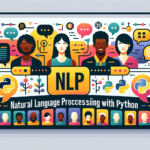Introduction to Natural Language Processing
What is Natural Language Processing (NLP)?
Ever chatted with Siri or Alexa and wondered how they understand your words? Dive into the world of Natural Language Processing (NLP)! In essence, NLP is the magical bridge between human language and computers, enabling machines to interpret, understand, and respond to human language. Cool, right?
Why is NLP Important?
Imagine a world where machines couldn’t understand our language. Frustrating, isn’t it? With NLP, machines not only “get” us but can also aid in tasks like translation, sentiment analysis, and so much more. It’s like giving your computer the power of language comprehension.
Python’s Role in NLP
Why Python?
Why is Python the darling of the NLP world, you ask? Well, Python’s simplicity and readability make it a favorite. Plus, its rich ecosystem of libraries makes NLP tasks a breeze. Imagine giving your computer a language tutor; Python does precisely that!
Key Python Libraries for NLP
Hold on to your hats, because Python boasts a treasure trove of libraries for NLP! Libraries like NLTK, spaCy, and TextBlob are like the superheroes of the NLP universe, each bringing its unique powers.
Getting Started with NLP in Python
Setting Up Your Environment
Starting your NLP journey with Python is like setting up a new gaming console. Exciting, right?
Installing Necessary Libraries
python
pip install nltk spacy textblob
With this simple command, you’re armed and ready to dive into the vast ocean of NLP.
Basic NLP Tasks with Python
Text Tokenization
Think of tokenization as chopping up a sentence into individual words. It’s like dissecting a delicious pie, one slice at a time.
python
from nltk.tokenize import word_tokenize
words = word_tokenize(“Hello, NLP world!”)
Part-of-Speech Tagging
Here, we label words based on their grammatical role. Imagine color-coding your wardrobe – that’s what we’re doing, but with sentences!
Advanced NLP Projects with Python
Sentiment Analysis
Ever wondered if a movie review was positive or negative without reading it? With sentiment analysis, Python can predict that for you!
Chatbots Creation
Thanks to Python and NLP, creating a basic chatbot is easier than you’d think. It’s like teaching your computer to converse!
Challenges and Considerations in NLP
Handling Ambiguity
Languages are tricky, and words can be ambiguous. Remember laughing at auto-correct fails? That’s ambiguity in action!
Scaling with Big Data
As with all things tech, NLP isn’t without challenges. When scaling up, handling vast amounts of data can be like trying to drink from a fire hose. But with Python’s tools, it’s manageable.
Conclusion
From understanding the basics of NLP to leveraging Python’s power for advanced projects, we’ve embarked on a fascinating journey. Natural Language Processing, with the aid of Python, is like handing our machines a key to the vast universe of human language. The possibilities? Endless!
FAQs:
-
Why is Python preferred for NLP?
Due to its simplicity, readability, and a vast ecosystem of libraries tailored for NLP tasks.
-
What are some popular Python libraries for NLP?
NLTK, spaCy, and TextBlob are among the top contenders.



